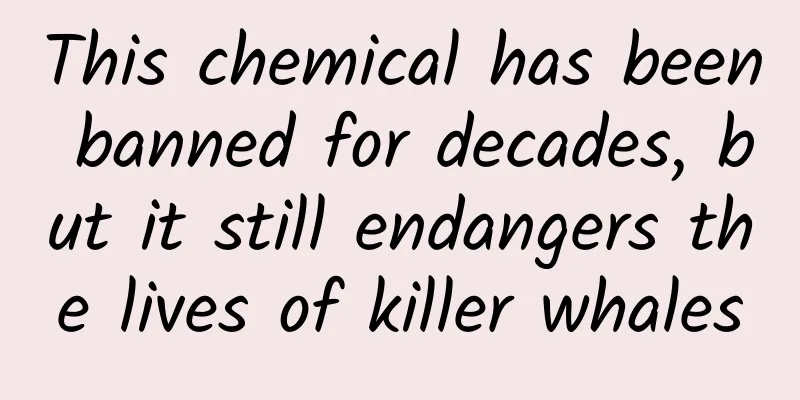This chemical has been banned for decades, but it still endangers the lives of killer whales

|
In the 2023 Nature Photographer of the Year competition, photographer Lennart Verheuvel won the award for his work "Last Gasp". The photo was taken in October 2022 and shows the last moments of a stranded killer whale on the coast of the Netherlands - it successfully returned to the sea under the guidance of rescuers, but just a few hours later, it stranded again and eventually died. Last Gasp|Photographer: Lennart Verheuvel The autopsy revealed that the killer whale was severely malnourished and had not eaten for a long time. We don't know why it was malnourished , but people may have some suspicions because the introduction of this photo on the official website of the competition mentioned that killer whales in European waters have the highest concentration of PCBs in the world. This toxic chemical, which has been banned for many years, has existed in the marine food chain for many years, harming the immune systems of animals, and even killer whales are not immune - because of it, half of the world's killer whale populations may face collapse within 30 to 50 years. The Dark History of PCBs Polychlorinated biphenyls (PCBs) are a class of synthetic organic compounds. Due to their low flammability, strong insulation and stable chemical properties, they were once widely used in the manufacture of capacitors, coolants, plasticizers, pesticides, oil paints, ship coatings, building materials and other products. The only problem with PCBs is that they are toxic . Since the 1930s, PCBs have been produced and used in large quantities, and have entered the atmosphere, rivers and oceans through exhaust gas emissions and wastewater from landfills. There have been many PCB pollution incidents in history . For example, in 1968 and 1979, residents in Japan and Taiwan, China, were poisoned by consuming rice bran oil contaminated with PCBs, and suffered skin lesions, immune system damage, nervous system disorders and other symptoms. PCB pollution has even spread to the Nunavut region of Canada, far away from its origin. In the 1990s, the Inuit living there, who mainly ate fatty fish and marine mammals, accumulated a large amount of PCBs in their bodies, with a concentration second only to that of victims of industrial accidents. Canadian Inuit traditionally hunt marine mammals | Canada North Outfitting It was not until the 1970s and 1980s that countries around the world determined that PCBs were highly toxic and carcinogenic, and gradually stopped using them. In 2001, more than 180 countries around the world signed the Stockholm Convention, banning the production of PCBs and agreeing to completely ban PCBs by 2028. However, there are still more than 10 million tons of PCB stocks in the world that have not been safely disposed of , and the remaining stocks are likely to continue to leak pollutants. Put yellow warning labels on transformers containing PCBs | US Army Corps of Engineers PCBs are a type of persistent organic pollutant (POP), which is a type of pollutant that is not easily decomposed and may take decades to degrade in the natural environment. It will circulate in the ecosystem for a long time . PCBs have been detected in the seawater of the Mariana Trench and the snow of the Arctic. In addition, PCBs can easily accumulate in the bodies of animals and plants, making it difficult to excrete. They can also spread through the food chain, endangering the health of humans, animals and plants. There is sufficient evidence that PCBs can cause cancer, birth defects, and brain, skin, blood and internal organ diseases in animals, and cause damage to the nervous system, immune system, endocrine system and reproductive system. Killer whales bear the brunt PCBs are the number one pollutant threatening wildlife in the Northern Hemisphere. A study of stranded California sea lions found that although both PCBs and DDT had been banned decades ago, the two toxins still caused a 23% cancer rate in adult California sea lions - such a high cancer rate in wild animals is unprecedented. California sea lion stranded after eating toxic algae | Channel Islands Marine & Wildlife Institute Killer whales are the animals most seriously contaminated by PCBs. Scientists have detected up to 1,300 mg of PCBs per kilogram in the fat tissue of a killer whale . Studies have shown that a level of 50 mg per kilogram is enough to affect the fertility and immune system of killer whales, and the content of 1,300 mg per kilogram is far higher than this value. PCBs harm the killer whales’ immune systems , increase their risk of disease, and severely impair their reproductive function , hampering their growth and brain development. As a neurotoxin, PCBs can cause killer whales to lose their sense of direction , further increasing their difficulty in catching prey. As starving killer whales lose weight, the proportion of PCBs in their bodies increases, further expanding the harm of the toxins. The deadly bond between PCBs and killer whales is related to the nature of PCBs and the habitat, physiological characteristics, and dietary structure of killer whales. Killer whales have a wide range of habitats, from Brazil and the Mediterranean to the Antarctic and Arctic regions. Killer whales around the world have been harmed to varying degrees by PCBs. The vertical axis of the right figure is the 1st to 10th layers of whale blubber, and the horizontal axis is the total content of PCBs; the study found that as the depth of whale blubber increases, the concentration of PCBs increases accordingly, which is the case for most pollutants|ScienceDirect The population of killer whales living in the Strait of Gibraltar and the northeastern Pacific has nearly halved in the past half century due to their proximity to industrialized areas. Killer whales living in Northern Europe and the polar regions, although far away from industrial production areas, mostly feed on marine mammals that are already rich in PCBs. It is estimated that PCBs are transferred from the water in the Arctic Ocean to plankton, and then move up the food chain to fish, seals, and polar bears. The concentration will increase to 3 billion times. This is the bioaccumulation effect. As a top predator, killer whales are at the top of the food chain and will accumulate extremely high levels of PCBs in their bodies. What's worse is that PCBs, as a lipophilic substance, easily accumulate in the fat tissue of animals. Compared with terrestrial animals, marine mammals need more fat to store calories, and killer whales are wrapped in thick blubber. Killer whale mothers' milk is also rich in fat, which will pass toxins to their cubs during lactation . Multiple threats facing killer whales In 2018, a female killer whale swam more than 1,600 kilometers in 17 days, carrying the body of her calf, which died half an hour after birth. This long and arduous mourning ceremony attracted worldwide attention. The southern killer whale population in the northwest Pacific to which this killer whale belonged had as many as hundreds of individuals in the 19th century, but by 2018 there were only 74 left . Scientists used a Labrador to track killer whale feces and found that nearly 70% of known pregnant killer whales failed , causing the birth rate to reach the lowest point in the past 30 years. They are worried that many killer whale families may not survive the next few decades. Tahlequah, the killer whale mother who swam 1,000 miles with her calf's body on her back | Taylor Shedd/Soundwatch There are three main reasons for the decline. First, the orcas feed almost exclusively on Chinook salmon, which are in rapid decline, and each orca needs to eat hundreds of pounds of fish every day. Second, ship noise interferes with the orcas' ability to echolocate, which prevents them from traveling farther to find food. Another reason has to do with toxic substances such as PCBs - when hungry and expending a lot of energy, orcas begin to metabolize fat, releasing toxic chemicals accumulated in the fat from the blubber into the blood . As climate change increases the temperature of Arctic waters, more killer whales may be attracted to the Arctic Ocean by warm waters to prey on marine mammals rich in fat and toxins. Multiple factors combined and interacting make it particularly difficult for killer whale populations to recover and grow. In January 2023, the first recorded orca stranding occurred off the Florida coast. The orca may have died of illness | Flagler County Sheriff's Office Killer whales have a maximum lifespan similar to humans, up to 90 years or more. This means that some killer whales born in the 1940s, when PCB use was at its peak, may still be alive today . The effects of PCBs are delayed, so killer whales exposed to PCBs as infants or embryos may not see effects until they are adults; similarly, killer whales that appear healthy today may already be at risk. Moreover, the long-term effects of PCBs need further observation and research. For example, in the 1960s, the population of harbor seals in Europe was greatly reduced due to PCBs, and then recovered rapidly in the late 1980s; however, soon after the government announced the end of the crisis, more than half of the seals were attacked by viruses and died. Long-term exposure to pollutants has greatly weakened the immune capacity of these seals. European harbor seal populations were decimated by PCBs | Wikipedia It’s hard to undo what’s happened, but we can’t stop trying The ban on the production of PCBs has improved the situation of killer whales, and the number of killer whales in some areas is currently increasing. But this is not enough. Countries also need to take action as soon as possible to clean up the PCB waste left in the stockpile and prevent new pollutants from leaking, so as to truly eliminate future problems. PCBs have been banned, but other persistent organic pollutants such as chlorinated paraffins and per- and polyfluoroalkyl substances (PFAS) are still widely used in the manufacture of hundreds of industrial consumer products. For chemicals that have been proven to be harmful to humans and the environment, the industry should gradually phase them out and replace them. An estimated 2,000 new chemicals are developed worldwide each year, and before they are put into mass production, more careful assessments should be made of their potential impacts and disposal methods. Environmental organizations collect plastic waste on the coast of the Philippines and create life-size sculptures of stranded whales|Dentsu Jayme Syfu The ocean seems to have become the largest chemical sink on Earth, and once toxic substances enter the ocean, it is difficult to remove them. But among the other problems facing killer whales, there are some that we can find solutions to. We need to work hard to curb the threats to killer whales from food shortages, ocean noise, plastic pollution and climate change, if we are to save the endangered killer whale population in time. Author: beastiebarks Editor: Mai Mai Image credit: Lennart Verheuvel |
<<: Use day cream during the day and night cream at night? Can I use whatever I want?
>>: The Chinese dragon once had wings
Recommend
What kind of methodology can continuously create popular marketing products?
For most marketers, screen swiping is something t...
Is it true that the sun once had a twin?
The Sun is the only star in our solar system, but...
The inspiration I got from writing code with my eyes closed
[[127460]] I am a programmer, and I am also a bli...
How to write product and promotion copy for Double Eleven?
The annual large-scale shopping festival is comin...
A famous actress lost 100 pounds. Can we copy her weight loss journey?
Review expert: Shen Yingjian, Director of the Nut...
By 2020, perhaps screen fingerprint and face recognition will coexist on the iPhone
In a few days we will welcome the new iPhone seri...
How would you let Uber do this? Google's patent for driverless ride-hailing is exposed
A lot of big news comes from patents. From 2009 t...
Baidu Apollo launches autonomous driving operation route in Beijing's sub-city center, "Carrot Run" starts in Tongzhou
On August 26, the launch ceremony of autonomous d...
How did “Her Community” win tens of millions of users in four months?
Anti-counterfeiting startups have now become an e...
Why did humans explode?
Recently, I saw some netizens discussing why spec...
Why don't Chinese planes flying to the US cross the Pacific Ocean?
The first human flight across the Pacific Ocean w...
iPhone drives up the average price of Chinese mobile phones: a blessing or a curse for China’s mobile phone industry?
Recently, Creative Strategies, an American market...
Eating cake = being poisoned? Does it really take 51 days to metabolize a mouthful of trans fatty acids?
Many people are familiar with "trans fatty a...
What are the advantages and disadvantages of Wancibaping promotion? How is the promotion of Wancibaping?
Presumably, many friends who are engaged in onlin...
The story between the domineering president and Internet TV
The story of radio and television is always long,...









